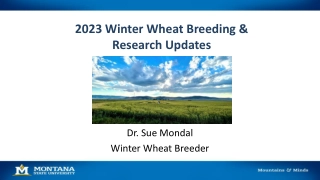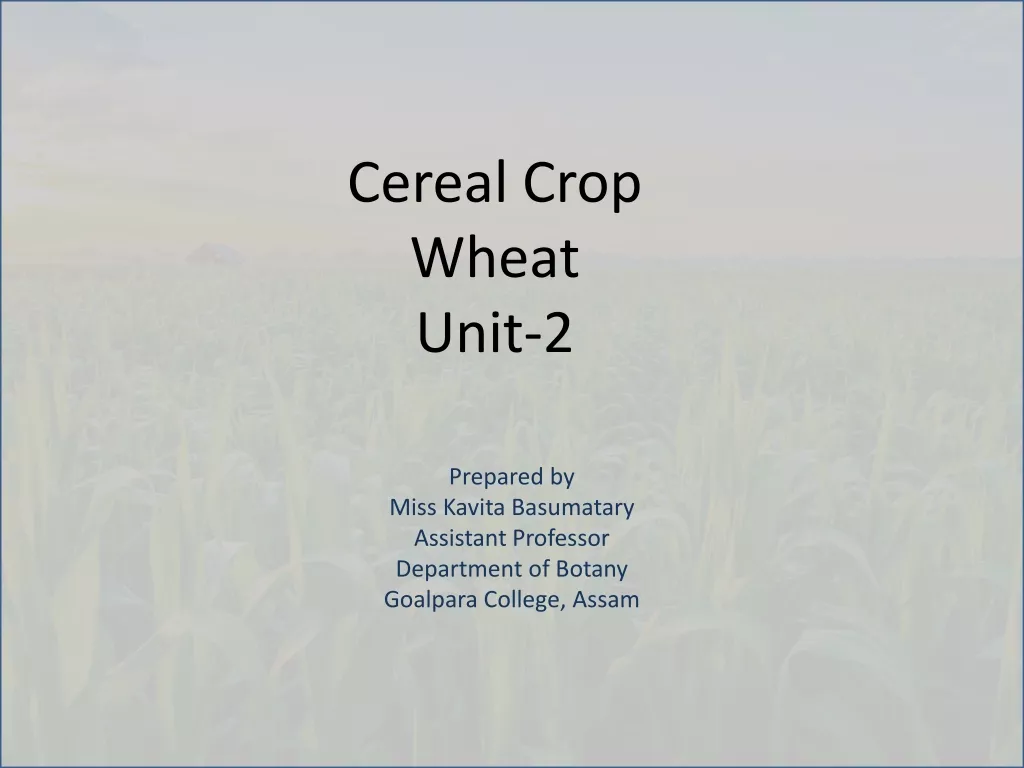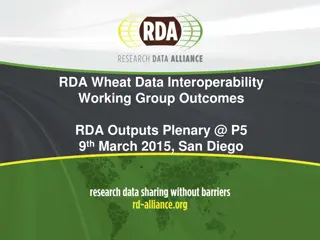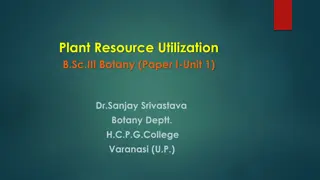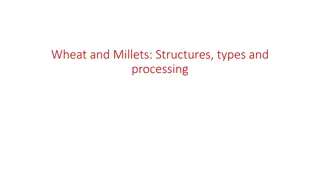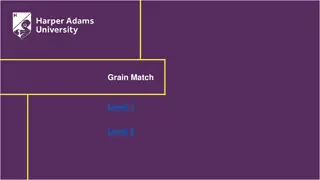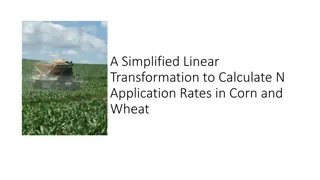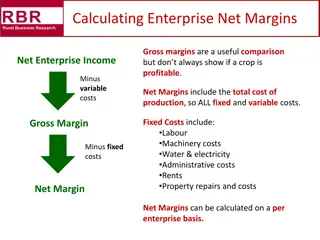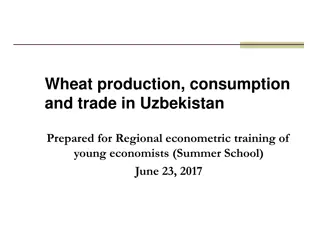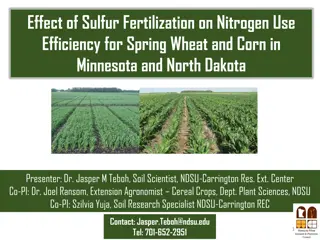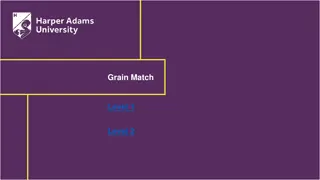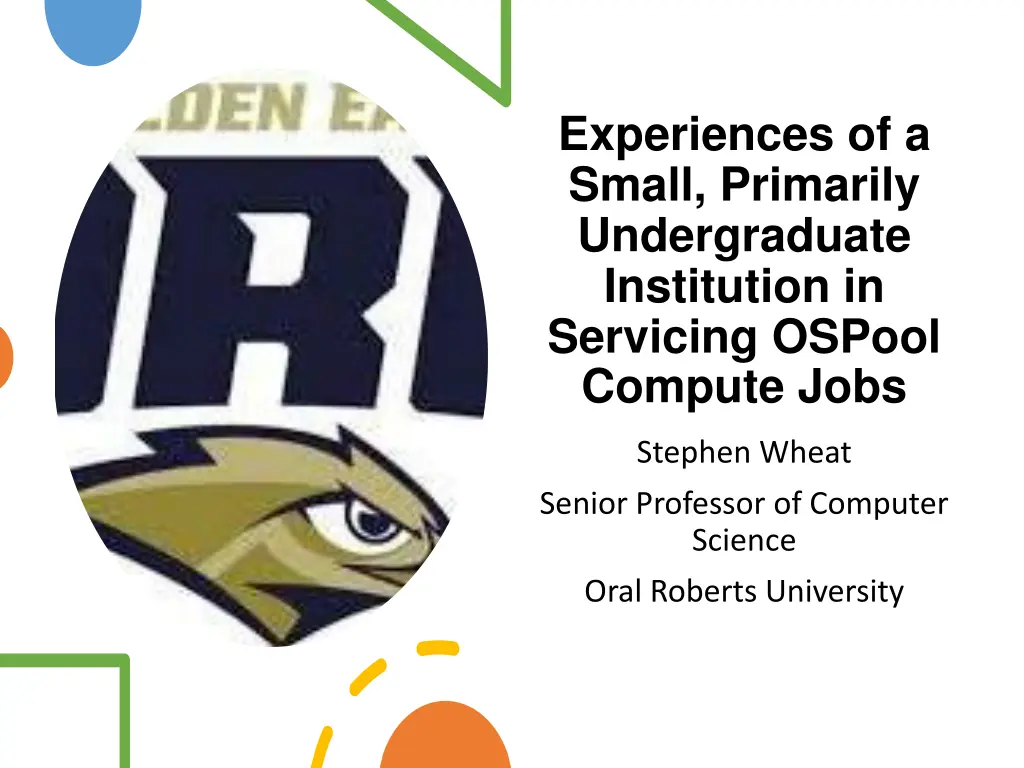
Empowering Research at Oral Roberts University with Titan Facility
Explore how Oral Roberts University utilizes the Titan facility to boost computational research, increase faculty and student engagement, and enhance academic opportunities in partnership with NSF initiatives and regional networks.
Download Presentation

Please find below an Image/Link to download the presentation.
The content on the website is provided AS IS for your information and personal use only. It may not be sold, licensed, or shared on other websites without obtaining consent from the author. If you encounter any issues during the download, it is possible that the publisher has removed the file from their server.
You are allowed to download the files provided on this website for personal or commercial use, subject to the condition that they are used lawfully. All files are the property of their respective owners.
The content on the website is provided AS IS for your information and personal use only. It may not be sold, licensed, or shared on other websites without obtaining consent from the author.
E N D
Presentation Transcript
Experiences of a Small, Primarily Undergraduate Institution in Servicing OSPool Compute Jobs Stephen Wheat Senior Professor of Computer Science Oral Roberts University
ORU Research ORU Research Comuting Facility (ORCA) hosts Titan Facility (ORCA) hosts Titan Titan consists of: 38 Broadwell nodes of 40 cores and 128 GB memory each. 280 Sandybridge nodes with 16 cores and 128 GB memory each. Nine Icelake GPU nodes, eight with 4x A30 GPUs and one with 4x T4 GPUs 100 GbE network to the OneOklahoma Friction Free Network (OFFN) and Internet2. Nearly 1.0 PB of storage for /home, /scratch, and /backup. Nearly 1.0 PB of S3 storage on the OFFN network. An additional 1.5 PB of cold storage for TBD uses. ORCA space and cooling can facilitate 3x the current power configuration. 500 KW yet to be piped in. Comuting and Analytics and Analytics
History of Titan History of Titan 2018: Original donation of 32 compute nodes from HPE with 100 Gb OPA fabric. 2019: NSF CC* 1925744 Regional Network 100 GbE connectivity to OFFN (One Oklahoma Friction Free Network) for ORU and 10 GbE connections for East Central Univ of OK and Cameron Univ. 2020: NSF CC* 2018766 Regional Compute Dedicated OSG Compute Node as part of the regional project. 2022: Donation of 400 compute nodes with IB QDR fabric. 2022: NSF CC* 2201435 Campus Compute GPU partition (8 GPU nodes with 4x A30 each) and ~ 1PB of NSF and BeeGFS storage
Titan Usage Titan Usage Free access to Titan for any academic: In Oklahoma who is part of the OneOklahoma Cyberinfrastructure Initiative (OneOCII) https://www.oneocii.okepscor.org/ In the Great Plains Network (GPN). Others on case-by-case basis. Major usage from 2022-2025, with 90+% utilization ORU: 39% University of Tulsa: 43% Southeastern Oklahoma: 12% Univ of Missouri: 2% SIL Global: 3% OSPool GlideIns: 2%
Impact of Titan at ORU Impact of Titan at ORU Previous to Titan, computational research was minimal at ORU. ORU is primarily a teaching university and is a predominantly undergraduate institution. Titan has increased the research participation of ORU faculty and students, in no small part due to the NSF support that we have received. Research efforts span several disciplines and involve both traditional HPC and AI/ML/etc.
Timeline of OSG Engagement Timeline of OSG Engagement 2021: Deployment of the GP-ARGO OSG compute node 2023: Finalized the Hosted CE configuration for use of the Broadwell partition. 2025: Extended the Hosted CE allocation to include nodes in the Sandybridge partition. While these are much older nodes, they do have 128 GB of DRAM each, thus supporting those jobs that need more memory per core than usual.
Experience in hosting OSG jobs Experience in hosting OSG jobs Dedicated node: Took about six months from the NSF award to deploying the node. The solution stack was installed and ran continuously in fire-and- forget mode for four years. In 2025, we re-instanced the node with Rocky 8.10 and reinstalled the OSG stack. It has been running flawlessly since then. We learned to look at the details we had forgotten about this node s configuration when we rearchitected the network in late 2024. It was isolated from the internet for four months before we found out. Hosted CE When we got involved, the Hosted CE stack was being refactored to better enable seamless deployment. We waited 18 months to start the process. Once started, the OSG team was on top of the details, meticulously checking out the deployment. Once going, this too was fire-and-forget. About a year ago, we were notified by the OSG team that we were likely experiencing disk data accumulation.
Experience in hosting OSG jobs Experience in hosting OSG jobs OSG support: Nothing but spectacular. Great response times, resolutions to issues in no more than a few hours. Graceful and patient for those of us that do not know the details. Unexpected consequences: After about six months, we learned that we needed to have a dedicated firewall/NAT switch as the large data downloads had a negative impact on the campus firewalls.
Experience Summary Experience Summary Working with the OSG team is very easy. Overhead for providing the Hosted CE environment is nearly 0% and is completely worry free. Regardless of the system staff size, supporting Hosted CEs is not an extra burden, once the system is configured. All of this is quite important for a small institution like ORU.
How this has all helped ORU How this has all helped ORU It is a straightforward way to help meet the requirements of the CC* solicitations. It could not be easier. ORU is now much more involved in the larger community. This is important for the administration who had been inexperienced with research computing and did not know what this community can mean for the university. The collaborations and engagement with this community have motivated additional faculty to expand their research participation.
Going Forward Going Forward Currently working on a 1 PB testbed S3 deployment to be made available to the OSPool and others. We have not been users of the OSPool. As our research teams continue to grow, we are starting to see some use cases that would be well-suited for the OSPool.
Acknowledgements Acknowledgements None of this would have been possible without the support of the following people/institutions OSG Team, with Tim Cartwright faithfully engaged for our success. NSF through the grants (granted and otherwise) and support of the REU efforts. Special call outs to Kevin Thompson and Amy Apon. The GP-ARGO team that got us involved in the HTC domain, call out to Dan Andresen (Kansas State) and James Deaton (Internet2) The ORU Administration and Board of Directors that have facilitated the infrastructure and space to bring Titan to life.

